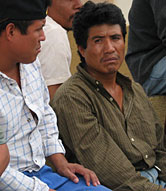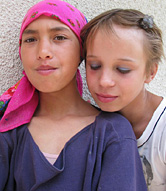by David Kyle
September 22, 2003
What drives the global boom in illicit human smuggling and trafficking?
Read the briefing (below) to find out what the U.S. is doing to stop the human cargo industry.
As a teenage resident of Naples, Florida, I was jarred by the contrast between my community, a sunny playground for some of the wealthiest people on the planet, and the town of Immokalee down the road. Just 50 miles away, it looked like a production crew had built a film set located in poverty-stricken rural Mexico.
Sure, the economic disparity within Collier County was striking, but someone had to pick our crops; wasn’t the fate of entire families of “seasonal farm workers” better than what they had left behind? As it turns out, the answer has been increasingly “no.”
In fact, many of the migrant workers in Immokalee were victims of human trafficking. Potential migrants often enlist the aid of smugglers in order to illegally enter a prosperous country where they hope to find work. Human trafficking takes place when such migrants are manipulated by their smugglers: Forced to pay an exorbitant fee, many are made to work off their debt by laboring under slave-like conditions. Women are often obliged to enter the sex industry as prostitutes or exotic dancers.
Migrant smugglers make the majority of their profits by exporting people across borders much like travel agencies, sometimes even offering guarantees of multiple attempts in the event the migrant is caught. Human traffickers often lure en route migrants away from their traveling companions, or — more commonly — pose as trusted migrant smugglers who simply want to help them find a job abroad. Once the migrants arrive, however, they are made to pay rolling “debts,” set by the traffickers with the threat of violence. Traffickers rely on intimidation, as well as the migrants’ lack of state authorization or the cultural and linguistic skills necessary to seek help, to ensure the captivity of their victims.
Two questions arise given this situation: What is the United States, as the world’s wealthiest and most powerful nation, doing to curb human trafficking? And, why is migrant smuggling, the foundation of the much more insidious slave trafficking rings, such a growth industry?
In addition to several new programs and agencies to catch traffickers and educate would-be migrants about the risks of clandestine migration within every major branch of the U.S. government, the most significant action to date was enacting The Victims of Trafficking and Violence Protection Act of 2000. This legislation increases penalties for traffickers and potentially provides protection and social services for trafficking victims while their cases are being investigated, including the issuing of a special, though temporary, T1 visa. In addition, the U.S. State Department releases an annual report ranking nations throughout the world on their efforts to reduce human trafficking; starting this year, the non-humanitarian aid of those states deemed at the bottom tier of non-compliance with international enforcement standards may be eliminated, barring a waiver by President Bush.
Clearly, laws and law enforcement are not enough. The U.S. State Department’s 2003 report on human trafficking estimates that between 18,000 and 20,000 of the world’s 800,000 to 900,000 trafficking victims are brought to the United States each year. In 1998, then U.S. Attorney General Janet Reno said, “We must get these modern day slavery cases off the front pages of the newspapers and into the history books.” Five years later, we are seemingly no closer to this ideal, though a growing number of countries and people around the world are getting involved in preventing trafficking and helping those already trapped by it.
While better laws and policies to stop trafficking are being developed in the United States and around the world, encouraging more law enforcement is a two-faced solution. Source countries often profit from the payments of migrants and slaves and thus are not always willing to comply, or are rife with corrupt officials who profit personally from trafficking. In contrast, destination states’ primary emphasis has been on making it more difficult to enter their territories illegally. This often has the effect of driving even more potential migrants to the services of professional smugglers, raising the costs of smuggling services, and thereby attracting the involvement of organized crime into an increasingly lucrative business.
These unintended consequences of particular measures intended to stop human smuggling are nearly always counterproductive without an integrated approach that is sensitive to the root causes at home and that also goes after, in equal measure, those who profit from illegal labor — especially slaves. The most striking contradiction to the notion of economic globalization — the free trade of goods made possible by sophisticated technology — is how countries have responded to this new global challenge with more restrictive and ever-changing controls on international labor migrants and asylum seekers.
Just as the North American Free Trade Agreement was beginning to economically unify Mexico and the U.S. in the mid-1990s, large sections of the U.S.-Mexico border began to look like demilitarized zones between two hostile nations, complete with 70 miles of steel walls, new surveillance technologies, and a tripling of the U.S. Border Patrol. In the context of concerns in the post-9/11 era, a recently proposed project to build more than 260 miles of fencing along the border with Mexico would effectively seal off the state of Arizona — it would also be twice the length of the Berlin Wall.
The dislocating economic forces of globalization, which make workers, corporations, and states around the world compete as never before, has produced both a glut of relatively ambitious migrants and the demand by employers for ever cheaper labor. When we add to this the combination of the fall of the Soviet Union, freeing hundreds of millions without adequate work, and an even greater number who live in fear of state or societal repression and persecution based on ethnicity, gender, or political activism, we begin to understand the enormous market for human smugglers and traffickers.
Today, while the vast majority of countries advocate the ideal of free markets and free people, those ambitious or desperate enough to leave a beloved community for a new beginning in another country typically find that their ability to move about the planet is severely restricted: There are political limits to an increasing supply of potential migrants relative to the perceived demand in developed destination countries, which have been experiencing growing levels of lay-offs and under-employment.
In this sense, the global business of migrant smuggling and human trafficking is a symptom of the disparity in mobility of the world’s peoples during what is otherwise the historical zenith of mutual global awareness and interconnectedness. The optimistic possibility is that this sense of mutual awareness may lead those of us with freedom and economic power to help those nearby who have none.
Back in Florida, for instance, some progress has been made for the migrants of Immokalee. In 1997, the Coalition of Immokalee Workers began to organize several anti-slavery protests, which over the last five years have resulted in the arrests of several slave traffickers and the freeing of thousands of workers held against their will. In 1998, Janet Reno created a Worker Exploitation Taskforce after the discovery of a slave importing scheme in which teenage Mexican females, some as young as fourteen, were coerced into prostitution in farm labor camps throughout Florida and other nearby states. Immokalee, and other nearby Florida towns dominated by migrant laborers, make up one of many regions around the globe in which slavery is prevalent, another subset of the 25 to 30 million slaves in the world today who need someone’s help.



